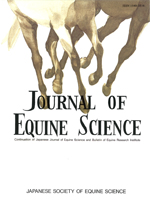All issues

Volume 23 (2012)
- Issue 4 Pages 47-
- Issue 3 Pages 35-
- Issue 2 Pages 17-
- Issue 1 Pages 1-
Volume 23, Issue 4
December
Displaying 1-1 of 1 articles from this issue
- |<
- <
- 1
- >
- >|
Review Article
-
Orhan YILMAZ, R. Trevor WILSON2012Volume 23Issue 4 Pages 47-52
Published: 2012
Released on J-STAGE: March 06, 2013
JOURNAL FREE ACCESSMules are known to have been used as carriage and riding animals in Mesopotamia and Anatolia as early as the beginning of the second millennium BC but may have been first bred in Anatolia in the Third Century BC. They have thus contributed to Turkey’s cultural, social and economic heritage for more than 4,000 years and were an ancient component of its guild of domestic animals and overall biodiversity. Once bred country-wide most mules are now introduced “illegally” to the southeast and east from Iraq and Iran. Mules are now bred only in one small area in north-central Turkey close to the Black Sea. The major role as a pack animal has been usurped since the mid-twentieth century by increasing use of motor transport and numbers have declined rapidly since the early 1980s. In 2009 about 51,500 mules remained in Turkey, mainly distributed in discrete areas in the extreme southeast, the centre-south, the northwest and the centre-north. In the southeast the main role is in cross-border trade (much of it described as smuggling) whereas in other areas mules are used in support of pastoral and farming operations. Mules in Turkey are of various colours but are generally large and strong compared to those found in many other countries. Pressure on numbers will continue and will exert a negative effect on a part of Turkey’s national heritage and domestic animal biodiversity.
View full abstractDownload PDF (2370K)
- |<
- <
- 1
- >
- >|